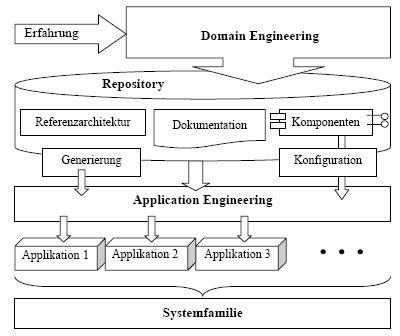Fundamentally by the configuration of the software architecture also the condition and expandability of the software are determined according to the implementation.
Therefore follow after the introduction for the development of computer families the exact analysis of the paradigms, architectures and auxiliary tools already mentioned in the preceding chapter, which are used with the production by families in the first phases.
Software development places requirements within the range of new areas of application, complex tasks and increasing requirements,
within the range quality with serious consequences of software errors, acceptance criteria, differently defined software quality and rising need
of new systems and variants, increasing demand and the insufficient function cover of standard software. In addition the load comes by the high life span of old
systems and their connection of developer capacities, which must be considered with new systems. Here well-known systems of the re-use of software intervene by
means of component-based software development. A goal is the economical, generation specific to a request of a large number of qualitatively high-quality system
variants, those to be automated to a large extent kann.81
In the context of this thesis (diploma) components are
defined as follows:
Definition: Components82
A component is consisting "a component of a whole one ", in computer science an final part of a software program of a consequence
of processing steps and data structures. Strongly cohesive contents contain application orientated, semantically belonging together functionalities like re-usable computations or working on steps of data, whereby interfaces make these available outward. Over the interfaces excluding data are taken over or delivered, contents of the component remains totally enclosed. They must be to a large extent redundancy-poor, again usable, freely combinable and openly conceived, in order to be able to make changes. Modules can contain one or more components. Plugins are similar to the components, represent however often more autonomous parts.
Table 12: Definition of a component
Ulrich W. Eisenecker et al. designate the advantages of the computer families such as follows83 : "The software development is predominantly aligned to the production of individual systems, although everywhere to the necessity for re-use one refers. But how the development of unique pieces is to bring something re-usable out? Bring Frameworks, draft samples and software components in this regard improvement, but no break-through. However the a coil of computer families promises a substantial progress. It makes the manufacturing specific to a request for a large number of system variants possible, and which can to a large extent is automated. This permits the drastic lowering of development times and - substantial improvements of the quality as well as cost. "In this thesis (diploma) a computer family is defined as follows:
Definition: Computer families84
A computer family is a software system, which from a reference architecture, which documentation and different optional and mandatory components exist, which permit an automizable derivative of a family member. The flatable and comprehensive use of components in an application domain is the center of attention as large temporal and economic factor. Also the term "line "is equivalently used in the literature
Table 13: Definition of computer families
The technical side of a computer family and the derivative of the family members are to be inferred from the illustration 3. The configuration of an application is manufactured automatically thereby on the basis the existing components and the reference structure by means of a generator. The diagram can be inferred from the following illustration:

Illustration 3: The draft principle of the Computer families 85